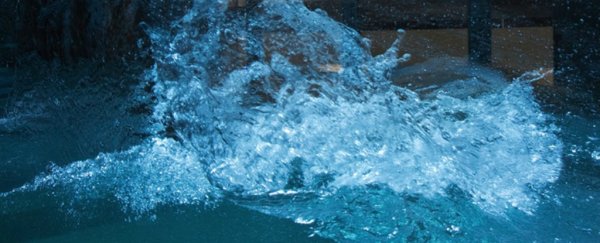Understanding more about the science of hurricanes can help to forecast climate change and even save lives, but of course getting up close to one of these phenomenally powerful quirks of our weather system is fraught with danger.
That's why the University of Miami has spent some US$45 million on an indoor laboratory capable of producing hurricanes up to a category 5 level (the strongest there is, with wind speeds reaching more than 252 km/h (157 mph).
The lab is called SUSTAIN – that stands for SUrge STructure Atmosphere INteraction. It comprises a 23-metre (75-foot) long, 114,000-litre (30,000-gallon) acrylic water tank, a 1,700-horsepower fan, and a 12-paddle wave generator that together can create all manner of waves and weather conditions.
"We can create the equivalent of a hurricane with winds over 200 miles-per-hour," SUSTAIN director and oceanographer Brian Haus told Popular Science. "That's an off-the-charts Category 5."
The equipment housed at SUSTAIN can be coded to recreate historical storms of the past: that gives scientists the opportunity to measure wave and wind patterns for hurricanes that have long since dissipated. They can also monitor the differences between different categories of storm and ultimately advise governments and authorities on the best ways to tackle them, thanks to the data pulled from the lab.
There are various different uses for the specialised hardware inside the SUSTAIN lab: testing the resilience of model houses and buildings, for example, studying how sea spray affects the growing intensity of a storm (due to the transfer of heat from the water to the atmosphere as spray is generated) and also tracking the way carbon dioxide moves from the ocean to the air during a hurricane.
Results of all of these experiments can prove invaluable to researchers studying the effects of storm systems.
"We really want to understand what happens when the atmosphere and the ocean meet in a really intense hurricane," Haus said in an interview with The Weather Channel, "and how the momentum that comes from the wind makes the waves and generates the really intense conditions that impact our beaches and coastal communities."
The University of Miami itself is situated on a bay prone to storm surges.
SUSTAIN doesn't mean researchers are going to be spending all of their time indoors, however. In the near future, the team plans to launch 1,000 floating drifter devices into the Gulf of Mexico in an attempt to plot how oil moves across the ocean, thus giving us a better chance of cleaning up the next spill effectively.
The research and development of sensors used out in the real world is another way the SUSTAIN lab is proving valuable to those studying the oceans and the weather patterns on top of them.
